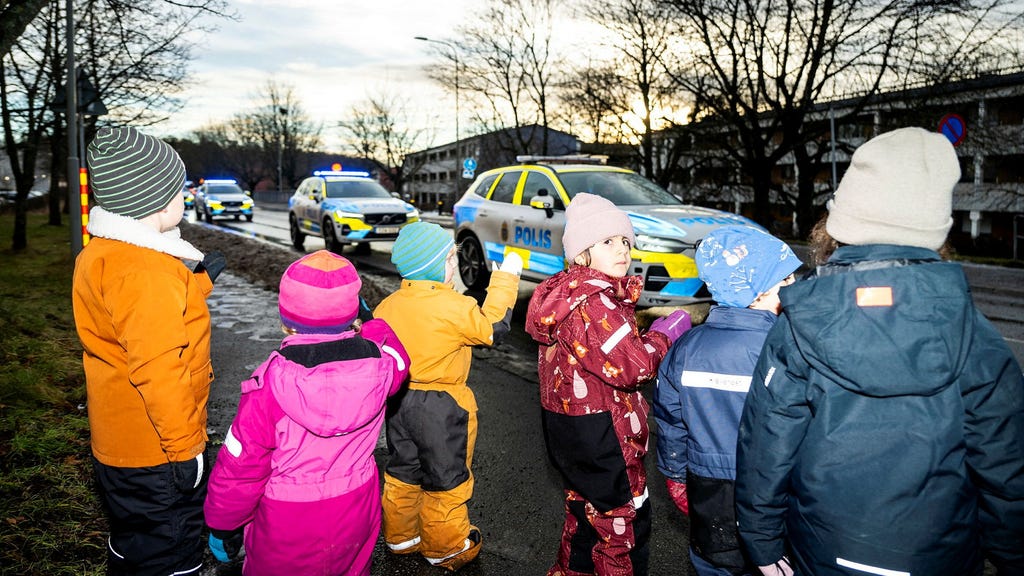The inauguration of the new police station in Skärholmen, a southern district of Stockholm, was marked by a celebratory atmosphere, complete with trumpet fanfares and a police car procession. However, the festivities were overshadowed by the stark reality of the area’s persistent struggles with safety and security. Located near the very spot where a 39-year-old father, Mikael, was tragically murdered the previous year, the new station serves as a constant reminder of the challenges facing the community. The district has grappled with a pervasive sense of insecurity, and the local social services department has recently experienced a significant exodus of staff, with approximately 20 employees resigning during the preceding autumn.
Local police chief Susan Friberg emphasizes the symbolic importance of the police station’s location in the heart of Skärholmen. She believes the readily visible presence of law enforcement will serve as a powerful reminder to residents of the ongoing efforts to combat crime and enhance safety. The constant visibility, she argues, is crucial in areas plagued by high crime rates and a pervasive sense of unease. The new facility isn’t a newly constructed building; rather, it’s a repurposed structure that formerly housed the district administration. The red brick building has undergone extensive renovations to meet the specific needs of the police force, including the creation of specialized child interview rooms designed to foster a safe and comfortable environment. Importantly, the station will also house social workers who will collaborate closely with the police, a partnership Friberg considers essential. She highlights the distinct yet complementary roles of the police and social services, emphasizing their shared objective of community well-being.
Karin Wanngård, Stockholm’s finance commissioner, also present at the inauguration, acknowledges the deep-seated anxieties of many Skärholmen residents. She underscores the critical importance of effective cooperation between the city and the police in addressing these concerns. Wanngård highlights the vital role of social services in preventative work, emphasizing its contribution to overall community safety. Addressing the significant staff turnover within the Skärholmen social services department, Wanngård downplays the situation, claiming the turnover rate isn’t unusual. She attributes the departures to a broader trend of social worker resignations across Stockholm. However, when pressed about the specific number of resignations, she admits that while the 5.5% turnover rate in Skärholmen isn’t statistically anomalous compared to other districts, it is notably high in comparison to other professions. Wanngård acknowledges the need for ongoing efforts to improve the work environment, ensuring that employees feel supported by management and have adequate resources.
Following Mikael’s murder, politicians flocked to Skärholmen, offering promises of support and improvement in front of the cameras. However, the promised funding for social services never materialized. Instead, the city has opted to accept a budget deficit within the department. Wanngård admits this isn’t a decision taken lightly, acknowledging that Skärholmen will likely operate at a loss, a situation the city has reluctantly accepted. Responding to concerns about safety in Skärholmen, Wanngård emphasizes the city’s ongoing efforts to improve the situation. She cites examples such as the installation of security cameras, the expansion of fiber optic networks, the opening of a ”fritidsbank” (a library of sports and leisure equipment), and the provision of free breakfast in municipal schools, all contributing to a safer environment. She urges Skärholmen residents to communicate their concerns and suggestions for further improvements, emphasizing the importance of community input in shaping future initiatives.
The inauguration ceremony, complete with a procession of police cars and mounted officers, aimed to project an image of renewed commitment to the safety and security of Skärholmen. The symbolism of the repurposed building, now a hub for law enforcement and social services, reflects the hope for a more integrated approach to tackling the complex challenges facing the community. However, the backdrop of recent tragedy and the ongoing struggles within the social services department serve as stark reminders of the deep-rooted issues that require sustained attention and resources. The high staff turnover, despite official assurances, hints at a potential disconnect between political rhetoric and the realities on the ground.
The contrasting narratives surrounding the new police station – the optimism of the inauguration versus the lingering anxieties of residents – highlight the complex and multifaceted nature of the challenges facing Skärholmen. The symbolic gesture of a new police presence, while welcome, must be accompanied by tangible improvements in resource allocation and a genuine commitment to addressing the underlying social and economic factors contributing to crime and insecurity. The community’s continued engagement and open communication with city officials will be crucial in ensuring that the promise of a safer Skärholmen becomes a reality.














